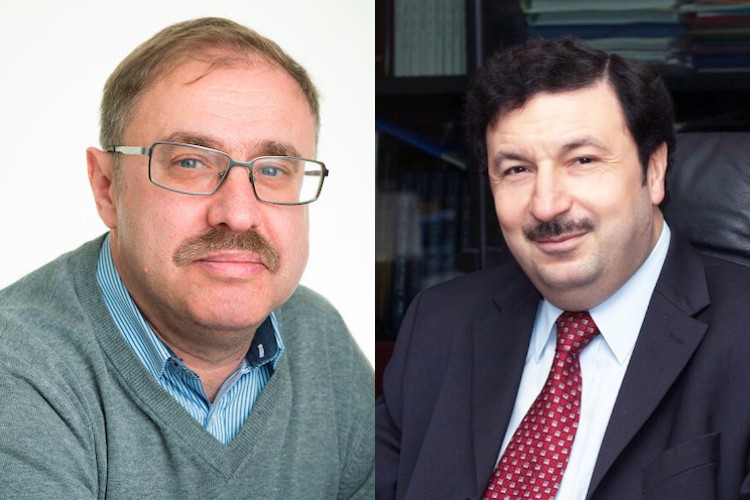In the runup to the 30th anniversary of the USSR’s dissolution, prominent Russian experts Vladimir Mau and Vladimir Gelman discuss the inevitability of the Soviet collapse, the fall of 1991 as a period of revolution, and the impact of the following decade’s legacy on modern Russia.

Vladimir Gelman (left) and Vladimir Mau define the 1991 disintegration of the Soviet Union as a period of revolution.
The event was hosted by the British Association of Slavic and East European Studies (BASEES) on October 12. Mark Harrison, emeritus professor of economics at the University of Warwick and author of several books on the Soviet economy, led the discussion with Vladimir Mau, rector of the Russian Presidential Academy of National Economy and Public Administrations (RANEPA), and Vladimir Gelman, professor of political science at the European University at St. Petersburg and the University of Helsinki.
Below are the key takeaways.
On the fall of 1991 as a period of revolution
Both experts classified the fall of 1991 as a period of revolution. It was a time of concern and fear but also of revolutionary enthusiasm and hope, with each day bringing “disorienting” new information. Gelman quoted Charles Dickens, “It was the best of times, it was the worst of times,” a statement clearly so broadly felt that Mau had also used it as an epigraph for his book, The Challenge of Revolution: Contemporary Russia in Historical Perspective (Oxford University Press, 2003).
Mau noted that revolution, being a transformation of the system and a diversion from the government’s vision, can bring about violence, though this happens when people don’t have much to lose. Still, violence is not an integral element of the 1991 revolution, even though it had become an essential part of the Soviet state’s modus operandi. Having witnessed the example of the Yugoslavian collapse, Soviet leaders might have wanted to avoid that kind of violent civil war.
Gelman agreed completely that peaceful disintegration of the USSR was a priority. Because of ethnic conflicts ranging from Nagorno Karabakh to Transnistria, the USSR thought it necessary to avoid the risk of major confrontations with its neighbors and territories. The Belovezha agreement signed on December 8, 1991, marked the official end of the Soviet Union, even as it was viewed as the “least unacceptable solution,” a “quick divorce” as opposed to lengthier and more difficult alternatives. Still, this agreement allowed the country to continue with economic reforms; without it, change would be much more problematic and complex—not only for Russia but also for its neighbors.
On the inevitability of the dissolution of the Soviet Union
A 20-year period, the 1980s and 1990s, surrounded the 1991 dissolution of the Soviet state—the former marked by the rule of Leonid Brezhnev and other Soviet leaders, the latter by Russia’s first democratically elected president, Boris Yeltsin. The question that many experts still ponder is: was the 1991 revolution avoidable? According to Mau, the turning point for a peaceful transition, following which the future collapse was inevitable, came in the 1960s and 1970s, when Soviet authorities tried to continue Khrushchev-era reforms, but issues related to oil and the artificial adjustment of revenue changed the structure of the Soviet economy. By the time oil prices collapsed in 1985–86, it was too late to reverse the downfall.
However, Gelman believes the point of no return was later, in the 1980s, and came as the result of Mikhail Gorbachev’s reforms. Gorbachev wanted to improve the Soviet system, but he had no idea what should be done and underestimated the scale of the problems he faced. Gelman suggested a thought experiment: imagine you could take a time machine and go to Gorbachev in 1985 to tell him what to do. As Gelman explained, when he poses this exercise to his students in class and discusses various alternatives, they always conclude that Gorbachev should have just preserved the declining status quo and done nothing—the result would have been the same.
On the role of the 1990s in modern Russia
The decade of restructuring the new Russian state immediately following the Soviet collapse has gone down in history as a period of terrible chaos. Today, 30 years down the line, experts ponder whether this reputation is justified. Gelman argued that many of the problems that surfaced in the 1990s had deep roots: the Soviet economy was falling apart during the Gorbachev period, and the long depression accompanied this process. On the other hand, Gelman noted, many of the policies of the 1990s resulted in the economic growth of the 2000s. These effects allowed Mau to suggest that the revolution period lasted from 1987 (the beginning of perestroika) to 1999/2000 (the first emergence of economic growth after a long period of depression and turbulence).
According to Gelman, the issues that plagued the first post-Soviet decade were based in the complexity of the so-called “triple transition”—transformations of the political, economic, and nation state-building systems. He argued that, on balance, Russia escaped the worst-case scenarios, but it is understandable that many people view the 1990s negatively given the contrast between the high hopes that characterized perestroika and the economic hardships of the first post-Soviet decade. Gelman also acknowledged that he had been very critical of the policies of Yeltsin and Prime Minister Yegor Gaidar, but through the perspective that thirty years brings, he came to realize his blame was unjust, because in order to make a more accurate judgement, one must take into account possible—far worse—alternatives.
* Liya Wizevich is a leadership team member at the Stanford U.S.-Russia Forum. She holds B.A. in Russian and East European Studies from the University of Pennsylvania and M.Phil. in History from the University of Cambridge.

